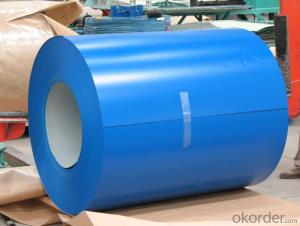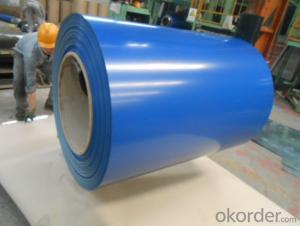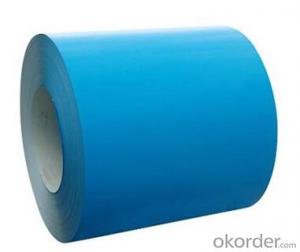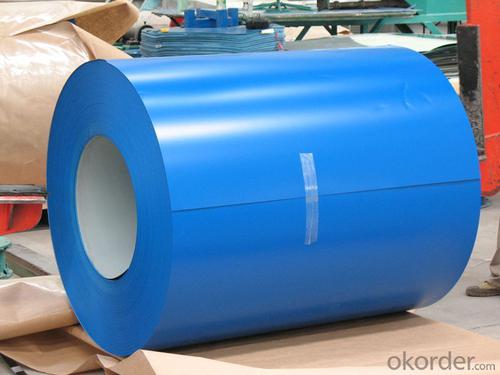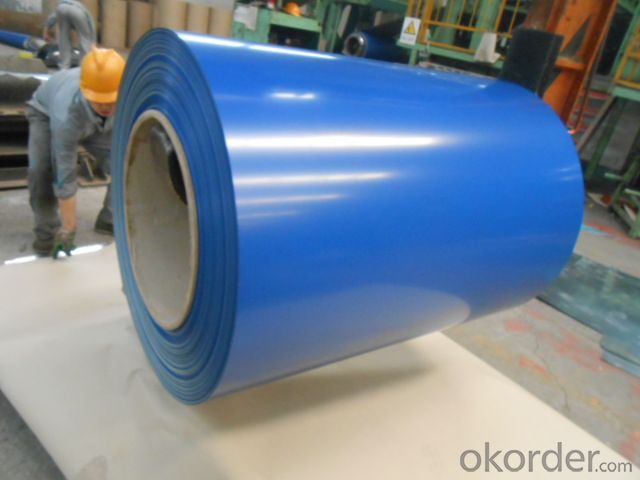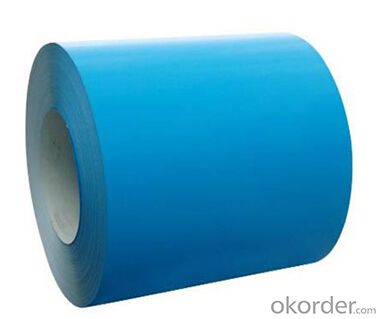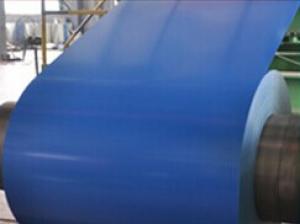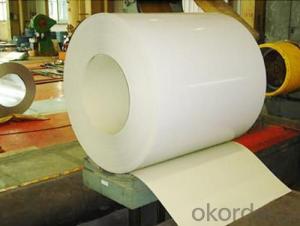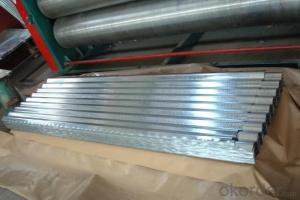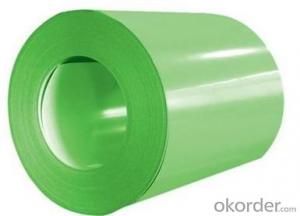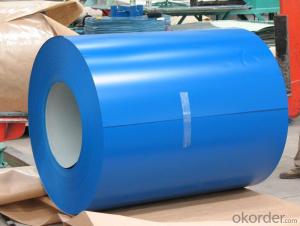Pre-Painted Galvanized/Aluzinc Steel Coil with Best Quality
- Loading Port:
- Shanghai
- Payment Terms:
- TT OR LC
- Min Order Qty:
- 50 m.t.
- Supply Capability:
- 10000 m.t./month
OKorder Service Pledge
OKorder Financial Service
You Might Also Like
1. Pre-Painted Galvanized/Aluzinc Steel Coil Description:
With GI as base material, after pretreatment (degrease and chemical treatment ) and liquid dope with several layers of color, then after firing and cooling, finally the plate steel is called pre-painted galvanized (aluzinc) steel. Pre-painted galvanized steel is good capable of decoration, molding, corrosion resistance. It generally displays superior workability, durability and weather resistance.
2.Main Features of the Pre-Painted Galvanized/Aluzinc Steel Coil:
• Excellent process capability
• Smooth and flat surface
• Workability, durability
• Excellent heat resistance performance
• High strength
• Good formability
• Good visual effect
3.Pre-Painted Galvanized/Aluzinc Steel Coil Images

4.Pre-Painted Galvanized/Aluzinc Steel Coil Specification
Standard: AISI, ASTM, BS, DIN, GB, JIS
Grade: DX51D, DX52D
Thickness: 0.17-2.0mm
Brand Name: KMRLON
Model Number: coil
Type: Steel Coil
Technique: Cold Rolled
Surface Treatment: Coated
Application: Boiler Plate
Special Use: High-strength Steel Plate
Width: 20-1250mm
Length: customized
commoidty: pre-painted galvanized steel coil
Thickness: 0.13-4.0mm
width: 20-1250mm
zinc coating: 40-180g/m2
printing thickness: top side: 20+/-5 microns, back side: 5-7 microns
color: all RAL color
surface treatment: color coated
coil weight: 4-7 tons
coil ID: 508/610mm
packaging: standard seaworthy packing
5.FAQ of Pre-Painted Galvanized/Aluzinc Steel Coil
What’s the application of this product?
Roof, roof structure, surface sheet of balcony, frame of window, etc.
What’s the brand of the paint?
We use the best brand of all of the word—AKZO.
- Q: what is the differance between ceramic and stainless steel headers and 4-2-1 and 4-1 and which are better for racing and should i get ceramic or stainless steel headers???? for a 98 civic
- 1) okorder ... The top two are of 4-1 design. Good luck, have fun.
- Q: What are the different types of steel coil edge trimming methods?
- There are several different methods used to trim the edges of steel coils, including slitting, shearing, and laser cutting. Slitting involves using circular blades to cut the edges of the coil, creating narrower strips. Shearing is a process that uses a straight blade to cut the coil edges. Laser cutting is a more advanced method that uses a laser beam to precisely trim the edges of the steel coil. These methods are used depending on the specific requirements of the steel coil and the desired end product.
- Q: i need some ideas of what material could replace iron or steel to make fridges, stoves, dishwashers, tractors, aircrafts, cars and buses and anything else that is made of iron and steel. anything is greatly appreciated as at the moment i have no idea what to put down.
- Material selection is a complex area. Iron and steel are very good materials in terms of their strength, stiffness and hardness (especially when compared to their density to give specific strength/stiffness. They are also relatively cheap and the economics of material selection is often the over-riding criteria. Each individual substitution has to be considered on the merits of what the component has to do and the environment in which it operates and often to replace steel with, say, aluminium, might not be appropriate or might require a redesign of the component to accomodate the lower strength and stiffness. Take one of your examples of a dishwasher; To replace the (cheap and thin) steel outer casing with aluminium would require thicker sheet to achieve the same stiffness. To replace the stainless steel inner you would need a corrosion resistant material (which rules out aluminium) which can be easily fabricated to shape. Nickel alloys would be harder to process and very expensive, but you might be able to use a bronze alloy. If you have time look in the library for a book on materials selection by Ashby - one of the best texts on the subject.
- Q: I work in a steel foundry 10-12 hours a day where we melt and pour stainless steel tubes. The pour temperature for some of them is very close to the boiling point of stainless steel (about 3800 degrees) because it has to be VERY liquid for the application we use it. Anyway, it does boil a little and we breath in the vapours which I can assure you ARE indeed vapourized stainless steel (it collects and cools on everything and makes a nice shiny coating). Ok, so to the question, does breathing vapourized stainless steel all day pose a health risk such as cancer? Anyone know? I'm just curious.
- I would imagine it's not good. I doubt cancer but I suppose it may be possible. Shouldn't you guys have respirator gear on? Where's OSHA when you need'em? ;)
- Q: What are the different types of welding methods used for steel coils?
- There are several different types of welding methods commonly used for steel coils, including spot welding, seam welding, and flash butt welding. Spot welding involves applying heat and pressure to two overlapping pieces of metal to create a strong bond. Seam welding is similar to spot welding but is used for continuous welds along the length of the coil. Flash butt welding involves using an electric current to create a heat source between two ends of the coil, which are then pressed together to form a solid weld. These methods allow for efficient and effective joining of steel coils in various industrial applications.
- Q: My musical saw has, despite my best efforts, got little patches of rust on it. How Do I go about removing the rust without spending too much on rust-removal products and without affecting the properties of the steel?
- Steel wool and a bit of WD 40. Steel wool will remove the rust and the WD 40 will protect it in the future.
- Q: Why people prefer prefabricated buildings these days? Recently my friend has told me that he is going to owe a steel house so I was just thinking are these steel structures really durable and cheaper than concrete structures?
- It really depends upon the environment and the construction techniques used. Steel that is painted or coated will without maintenance eventually rust. I would expect this tendency to be exacerbated in a humid or shore environment. Heat may tend to cook a steel house and the structure does not add much thermal mass. Construction techniques tend to be fairly quick a part of the construction is essentially prefabricated. Work done in a factory will almost always be cheaper than work done in the field, all things being equal. Concrete can be fairly hi tech with lots of equipment or as seen in many parts of the world fairly low tech with lots of laborers. It is easy to change the characteristics of concrete depending upon how it is mixed, reinforced, and treated during the curing process. Because it is applied in a relatively fluid state it can flow around obstructions like bedrock and be formed up into interesting shapes. A concrete structure can be cooler as it provides thermal mass, and a heat sink. It's resulting rigidity may make it more subject to earthquakes than steel. We do really need to be smarter in constructing our homes to make them fit the land and not only the general environment but our particular micro environment.
- Q: They are showing on tv a special on how the new World Trade Center, building 1, is being built. Focusing on the steel and the guys fitting everything together.Where do builders go to buy all that steel framing? We do not build really tall buildings where I live so most of the steel is cut and welded on the job site. At World Trade Center 1, they seem to get the steel on trucks; already cut and welded.
- Most of the parts are cut, welded, and fabricated indoors in a welding shop at another location. Then they're trucked to the site and simply need to be bolted together. This is made possible through the use of computer aided design and modeling programs, so that parts can be made to fit almost presciently in the field. They buy the steel from steel companies. I couldn't tell you exactly where it comes from, you'd have to ask the contractors themselves.
- Q: What are the common coil sizes available for steel coils?
- The steel coil sizes available for different industries and applications vary. However, there are standard sizes commonly used across sectors. These sizes include coil widths of 36 inches, 48 inches, 60 inches, and 72 inches. In terms of coil diameter, the most common sizes range from 20 inches to 24 inches. Furthermore, coil weights can vary greatly depending on the type of steel and its intended use, ranging from a few thousand pounds to tens of thousands of pounds. It is important to note that these sizes can differ among steel manufacturers, so it is advisable to consult the specific supplier or industry standards to determine the available coil sizes for a particular steel product.
- Q: How are steel coils used in the production of elevator components?
- Steel coils are used in the production of elevator components to manufacture various structural and mechanical parts. These coils are typically formed, shaped, and cut to create components such as elevator guide rails, brackets, frames, and support structures. The high strength and durability of steel make it an ideal material for these components, ensuring the safety and reliability of elevators.
Send your message to us
Pre-Painted Galvanized/Aluzinc Steel Coil with Best Quality
- Loading Port:
- Shanghai
- Payment Terms:
- TT OR LC
- Min Order Qty:
- 50 m.t.
- Supply Capability:
- 10000 m.t./month
OKorder Service Pledge
OKorder Financial Service
Similar products
Hot products
Hot Searches
Related keywords
